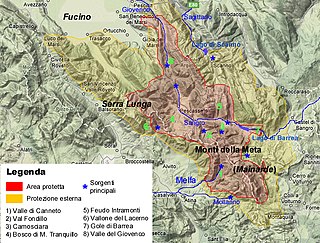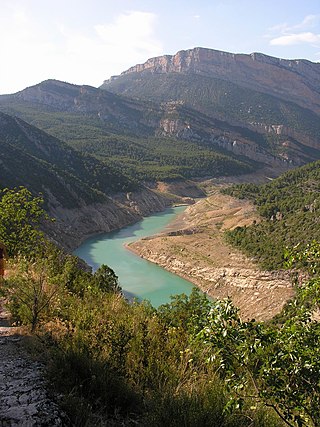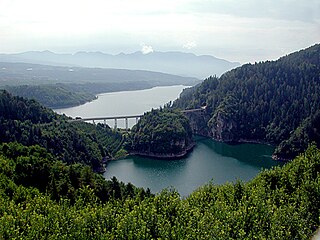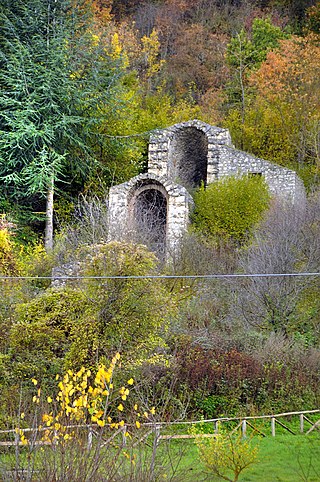
Antonio Margheriti, also known under the pseudonyms Anthony M. Dawson and Antony Daisies, was an Italian filmmaker. Margheriti worked in many different genres in the Italian film industry, and was known for his sometimes derivative but often stylish and entertaining science fiction, sword and sandal, horror/giallo, Eurospy, Spaghetti Western, Vietnam War and action movies that were released to a wide international audience. He died in 2002.

The Sangro is a river in eastern central Italy, known in ancient times as Sagrus from the Greek Sagros or Isagros, Ισαγρος.

Pietro Colletta was a Neapolitan general and historian.

Abruzzo, Lazio and Molise National Park is an Italian national park established in 1923. The majority of the park is located in the Abruzzo region, with smaller parts in Lazio and Molise. It is sometimes called by its former name Abruzzo National Park. The park headquarters are in Pescasseroli in the Province of L'Aquila. The park's area is 496.80 km2 (191.82 sq mi).

Liga Veneta Repubblica is a Venetist political party in Veneto, Italy. The party maintains a mildly separatist position and campaigns for the self-government of Veneto.

Scanno is a town and district in the province of L'Aquila, in the Abruzzo region of central Italy. It is one of I Borghi più belli d'Italia.
Barrea is a comune in the province of L'Aquila in the Abruzzo region of Italy.

The Noguera Ribagorzana or Noguera Ribagorçana is a river in northern Spain.

The Consulta Araldica was a college instituted by royal decree on 10 October 1869 to advise the Italian government on noble titles, coats of arms and related matters. It was a department of the Ministry of the Interior, combining the roles of the various heraldic colleges which had existed in pre-unification Italy, including the Tribunale Araldico of Lombardy, the Commissione Araldica of Venice and the Congregazione Araldica Capitolina of Rome.
Stelvio Massi, sometimes credited "Max Steel", was an Italian director, screenwriter and cinematographer, best known for his "poliziotteschi" films.

Lago di Santa Giustina is a lake in Trentino, Italy.

The Federation of the Left was an electoral alliance of communist political parties in Italy. The coalition was the evolution of the Anticapitalist and Communist List.
The Monti Marsicani are the sixth-highest group of Apennines located in the Abruzzo region, mostly in the Province of L’Aquila and partly in the Province of Frosinone and Province of Isernia. The highest peak is Monte Greco (2285m). They are limited in north by the Fucino plateau and Peligna Valley, on the east by the River Gizio and Altopiano delle Cinque Miglia, on the south by the Valley Sangro and Volturno, on the east by valley Liri and Melfa.

Cadorino, a dialect of Ladin, is the language of Cadore, at the feet of the Dolomites in the province of Belluno. It is distinct from neighboring dialects, and though it has received relatively little attention, it is important to an understanding of the linguistic history of northern Italy.

Tourism in Abruzzo has become one of the most prosperous sectors in the economy of Abruzzo, and in recent years has seen a remarkable growth attracting numerous tourists from Italy and Europe. According to statistics, in 2021 arrivals totaled 1,330,887. A total of 5,197,765 arrivals were tourists, a figure that puts the region seventeenth among the Italian regions for numbers of tourists per year. A moderate support to tourism is also given to the Abruzzo Airport with many low cost and charter flights connecting the entire region with the rest of Europe.

Lega per l'Autonomia – Alleanza Lombarda, also known as Lega per l'Autonomia Lombarda, was a left-wing regionalist political party in Italy, based in Lombardy.

Teatro Morlacchi, formerly Teatro del Verzaro, is the largest theater of Perugia. It is named after the musician Francesco Morlacchi.
The following is a timeline of the history of the city of Syracuse, Sicily, Italy. Syracuse was the main city of Sicily from 5th century BCE to 878 CE.
The following is a timeline of the history of the city of Salerno in the Campania region of Italy.

The Tunnels of Claudius consist principally of a 6 km-long tunnel together with several monumental service tunnels which Roman Emperor Claudius had built by 52 AD to partially drain the Fucine Lake in Abruzzo, protecting riparian villages from floods and creating agricultural land. It was a massive engineering project involving 30,000 workmen and slaves who completed it in just 11 years, and considered among the grandest in antiquity. It was the longest tunnel ever built until the inauguration of the Fréjus Rail Tunnel in 1871.


















